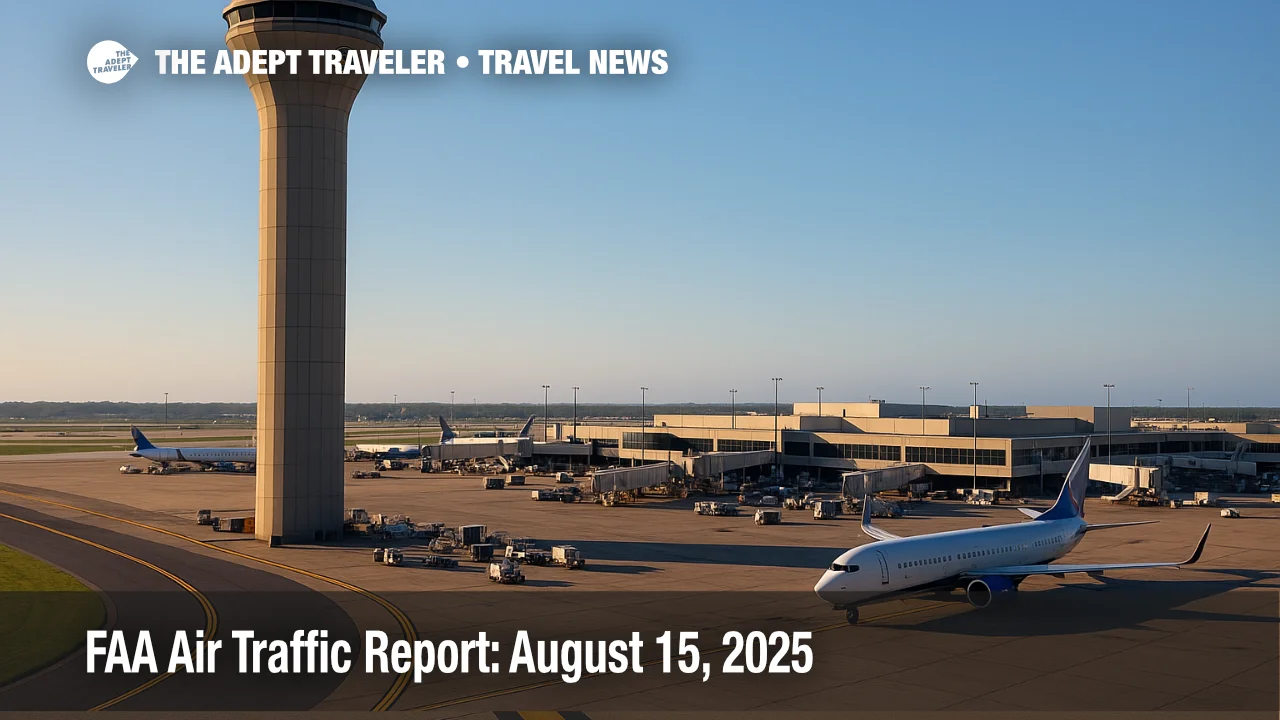FAA Air Traffic Report: August 15, 2025

U.S. air travel faces another weather-driven day, with thunderstorms forecast for the Mid-Atlantic, Florida, Minneapolis, Houston, Denver, and Phoenix. Winds are expected around the New York airports and Las Vegas, and low clouds linger in San Francisco, San Diego, and Seattle. The FAA has also posted a VIP Temporary Flight Restriction over Anchorage that could prompt programs, and the Command Center has flagged Seattle for probable terminal initiatives due to morning ceilings. Check airline apps for gate changes, crew timeouts, and rolling delays. Allow longer connections. Rebook early if a waiver appears. ## Key Points
- Why it matters: Weather, winds, and a VIP TFR may trigger delays, ground stops, or reroutes across key hubs.
- Travel impact: Seattle likely to see terminal initiatives; some flights bound for Seattle are already averaging about 40-minute departure delays. * What's next: Anchorage ground stop is possible around 1:00 p.m. CT, pending VIP movements and traffic demand. * Winds may slow New York and Las Vegas departures; low clouds may reduce arrival rates in the Bay Area and San Diego.
Snapshot
The FAA's morning outlook highlights thunderstorms near Ronald Reagan Washington National Airport (DCA), Washington Dulles International Airport (IAD), Baltimore/Washington International Thurgood Marshall Airport (BWI), Orlando International Airport (MCO), Tampa International Airport (TPA), Minneapolis-Saint Paul International Airport (MSP), George Bush Intercontinental Airport (IAH), William P. Hobby Airport (HOU), Denver International Airport (DEN), and Phoenix Sky Harbor International Airport (PHX). Expect wind-related spacing at LaGuardia Airport (LGA), John F. Kennedy International Airport (JFK), Newark Liberty International Airport (EWR), and Harry Reid International Airport (LAS). Marine-layer ceilings are possible at San Francisco International Airport (SFO), San Diego International Airport (SAN), and Seattle-Tacoma International Airport (SEA).
Background
The Air Traffic Control System Command Center manages national flow using tools such as Ground Stops and Ground Delay Programs to meter arrivals or hold departures when weather or volume lowers an airport's acceptance rate. Advisories are published continuously and updated as conditions change. Temporary Flight Restrictions can limit airspace near VIP movements, which may cascade into short-notice initiatives at nearby airports. For today, the Command Center notes Seattle for likely terminal initiatives because of ceilings, removed San Francisco from program consideration, and adjusted a potential Anchorage ground stop to a later window. ## Latest Developments
Storms across DC, Florida, Upper Midwest, and Rockies
Thunderstorms are expected to periodically slow traffic into DCA, IAD, BWI, MCO, TPA, MSP, DEN, and PHX, with convective cells also impacting Houston's IAH and HOU. Expect miles-in-trail restrictions, departure spacing, and reroutes along busy flows. Travelers should watch for rolling gate holds, especially when cells sit over departure fixes or final approaches. If your itinerary touches two storm-affected hubs, pad your connection or ask the airline to move you to a later bank.
Seattle ceilings drive initiatives, SFO removed from plan
The Command Center added SEA for probable terminal initiatives due to low ceilings this morning, while SFO was removed from the plan. Live FAA feeds already show some departures to Seattle taking around 30 to 40 extra minutes to push and taxi from certain origins. If you are connecting through Seattle midday, consider same-carrier options with longer layovers. ### Anchorage VIP TFR, program watch
A VIP TFR is active over Anchorage, and the Command Center has floated a potential ground stop at Ted Stevens Anchorage International Airport (ANC) around 100 p.m. CT, 1000 a.m. AKDT, depending on movements and demand. General aviation operators must check NOTAMs closely, and commercial flights may see gate holds while the window is active. ## Analysis
Today's constraints are classic summer patterns. Thunderstorms create rapid capacity swings, so even brief cells can ripple through afternoon banks at hub-and-spoke carriers. New York wind and Las Vegas gusts add spacing on busy departure corridors, increasing taxi-out times, especially during rush periods. Low ceilings at West Coast airports favor instrument approaches, which lowers acceptance rates and pushes minor delays into missed connections when banks are tight. With Seattle in program watch, expect airlines to protect their banks by trimming turns, which can strand inbound aircraft and crews out of position. Anchorage's VIP TFR is unusual in Alaska's busiest airspace, so shorter-haul flights may be timed to the TFR window, and longer-haul arrivals could be refiled to meet gate availability. The best hedge is to keep your airline app open, accept proactive rebooks that preserve your connection, and check bags only if necessary. ## Final Thoughts
If your plans touch the Mid-Atlantic, Florida, Seattle, or Anchorage, build in margin and keep alerts on. Wind in New York and Las Vegas, plus low clouds at Bay Area and San Diego fields, may stack taxi-out and arrival queues. When tight connections collide with pop-up initiatives, misconnect risk rises quickly. Confirm your contact info with the airline, monitor waivers, and move early if offered alternatives. Check real-time FAA status before you leave for the airport, then verify with your carrier. Safe travels, and see you in the next FAA air traffic report.
